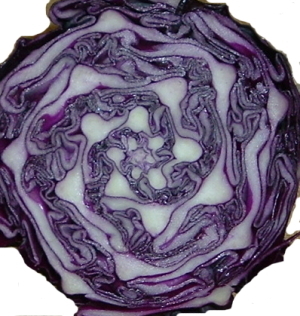Lies and Science
 It's no wonder I make stuff up. When I was a wee, innocent little child, before there was arugula and other greens that look like something you'd pay good money to eradicate from your lawn, restaurants that wanted to fancy up a salad would include shreds of purple cabbage. I was the pickiest of eaters (shut up, yes, I'm making up for lost time, no, I don't get out of the car and shovel up roadkill, I do have some standards), and I didn't want any of that weird purple stuff. "Don't see that color much in food," was my opinion. The only other purple food I'd ever seen was beets, and you know what I think of beets.
It's no wonder I make stuff up. When I was a wee, innocent little child, before there was arugula and other greens that look like something you'd pay good money to eradicate from your lawn, restaurants that wanted to fancy up a salad would include shreds of purple cabbage. I was the pickiest of eaters (shut up, yes, I'm making up for lost time, no, I don't get out of the car and shovel up roadkill, I do have some standards), and I didn't want any of that weird purple stuff. "Don't see that color much in food," was my opinion. The only other purple food I'd ever seen was beets, and you know what I think of beets.
So my mother said, "Don't you know what those purple things are? They're orchids. Some man climbed up to the top of a huge tree in a rainforest, with snakes and things all around him, to pick that orchid and carry it down to the ground, just so it could be cut up and put into a salad for you. Did he do all that for nothing?"
So I ate the damn cabbage. It was years before I saw a red cabbage in the grocery store and the truth came out.
I like red cabbage now, and see its beauty and have learned its coolness. For instance, did you know that the color of the cabbage depends on the pH level of the soil in which it grows? "Red" cabbage can be deep purple or greenish-yellow. When you boil red cabbage, it and the water turn blue. You can use that blue water to color Easter eggs, but it doesn't make a permanent dye for fabric (washes out after a couple of launderings or, I'll bet, sweatings).
And here's another cool thing: You can make your own litmus paper with red cabbage water. Even cooler: You can make green eggs to eat with your ham.
Don't you just love the interwebs? Me, too.
WRITING PROMPT: Make up a lie for a character's mother to tell him or her to get him or her to do something.
MA





